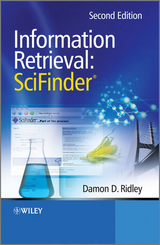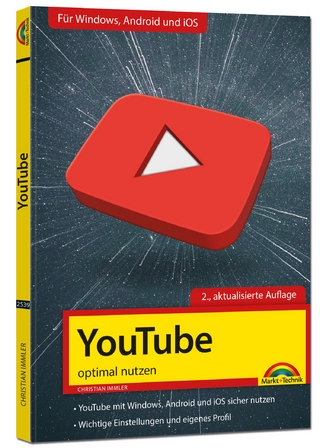
Information Retrieval
John Wiley & Sons Ltd (Verlag)
978-0-470-84351-2 (ISBN)
- Titel ist leider vergriffen;
keine Neuauflage - Artikel merken
Are you are a researcher, in industry or in academia, in the chemical, life, medical or physical sciences? - If so, this text will help you use SciFinder in a way which will increase your research creativity and productivity. Information retrieval is arguably one of the most important skills a scientist needs in the 21st Century. The SciFinder interface to the world's scientific literature is both unique and innovative and while it is intuitive and has a very user-friendly interface, searches will be performed more effectively and efficiently with an understanding of the databases involved and the processes by which SciFinder searches. This 'behind the scenes' look at SciFinder summarises the databases and explains how the user may creatively take advantage of the unique search opportunities provided. I have done a search but why did I get this answer? This text explains why, and more importantly, discusses how you may best use the 40+ options in SciFinder, such as topic, bibliographic and chemical substance explore options, to get the best answers possible.
Complementary rather than an alternative to the proprietary websites and manuals the book explains: the content of electronic information resources and why it helps if scientists understand some basic issues involved with information retrieval why it is important, and how, to apply scientific method to information retrieval selected algorithms behind the operation of SciFinder/SciFinder Scholar and why it helps to understand them for effective searching how to set up the search question and how SciFinder/SciFinder Scholar, essentially a research tool, may be used creatively to initiate research ideas why certain answers are retrieved and how to revise answers in a way that maximises comprehensive and precise retrieval of information
Preface. 1. What is SciFinder Scholar. 1.1 Introduction. 1.2 The Primary and Secondary Literature. 1.3 The SciFinder Scholar Option. 1.4 Types of Databases in SciFinder Scholar. 1.5 CAS Bibliographic Database (CAPLUS). 1.6 NLM Bibliographic Database (MEDLINE). 1.7 CAS Substance Database (REGISTRY). 1.8 CAS Regulatory Information Database (CHEMLIST). 1.9 CAS Chemical Catalog Database (CHEMCATS). 1.10 CAS Chemical Reaction Database (CASREACT). 1.11 Exercises. 2. Explore by Research Topic. 2.1 Introduction. 2.2 How SciFinder Scholar Converts the Query to a List of Candidates. 2.3 The Identification and Meaning of Concepts. 2.4 Choosing Candidates. 2.5 Working from the Reference Screen. 2.6 Saving and Processing Answer Sets. 2.7 Applying Scientific Method to Information Retrieval. 2.8 Summary. 2.9 Exercises. 3. Explore by Chemical Substance. 3.1 Introduction. 3.2 Registration of Substances. 3.3 Searching for Substances: The Alternatives. 3.4 Explore by Chemical Structure. 3.5 Analyzing and Refining Substance Answer Sets. 3.6 Explore by Substance Identifier. 3.7 Explore by Molecular Formula. 3.8 Special Cases. 3.9 Getting References. 3.10 Combining Explore by Chemical Substance and Research Topic. 3.11 Summary. 3.12 Exercises. 4. Additional Search and Display Options. 4.1 Introduction. 4.2 Explore by Author Name. 4.3 Explore by Accession or Patent Number. 4.4 Explore by Company Name/Organization. 4.5 Getting Related Information. 4.6 Property Information. 4.7 Sequence Searching. 4.8 Data Mining and Visualization. 4.9 Current Awareness. 4.10 Exercises. 5. Additional Search Strategies. 5.1 Introduction. 5.2 Further Issues with Finding Information on Substances. 5.3 Opportunities for MEDLINE Searches. 5.4 Searching for Substances in the Biological Sciences. 5.5 Searching for Information on Polymers. Exercises. 6. Searching for Chemical Reactions. 6.1 Introduction. 6.2 Specific Search Options in CASREACT. 6.3 Reaction Search Strategies. 6.4 Searching for Reactions Through Explore by Research Topic. 6.5 Combining Structure, Reaction, Functional Group, and Keyword Terms. 6.6 Exercises. Appendices. 1. Some SciFinder and SciFinder Scholar Resources. 2. CAS Roles in CAPLUS (including changes made in December 2001). 3. Some Basic Principles used by SciFinder Scholar in the Interpretation of the Research Topic Query. 4. Examples of Analyze References. 5. Registration of Substances. 6. Understanding Structure Searches. 7. Original Publication Discussed in Chapter 6, Section 6.1. 8. Overview of SciFinder Scholar Screens. Index.
| Erscheint lt. Verlag | 26.2.2002 |
|---|---|
| Zusatzinfo | index |
| Verlagsort | Chichester |
| Sprache | englisch |
| Maße | 152 x 229 mm |
| Gewicht | 420 g |
| Einbandart | Paperback |
| Themenwelt | Mathematik / Informatik ► Informatik ► Web / Internet |
| Naturwissenschaften ► Chemie | |
| Sozialwissenschaften ► Kommunikation / Medien ► Buchhandel / Bibliothekswesen | |
| ISBN-10 | 0-470-84351-9 / 0470843519 |
| ISBN-13 | 978-0-470-84351-2 / 9780470843512 |
| Zustand | Neuware |
| Haben Sie eine Frage zum Produkt? |
aus dem Bereich



